英文跨文化交际
- 格式:ppt
- 大小:271.00 KB
- 文档页数:17
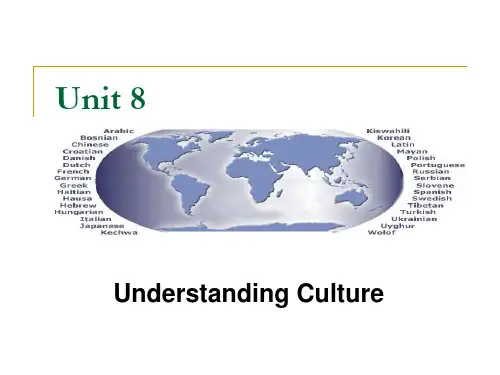
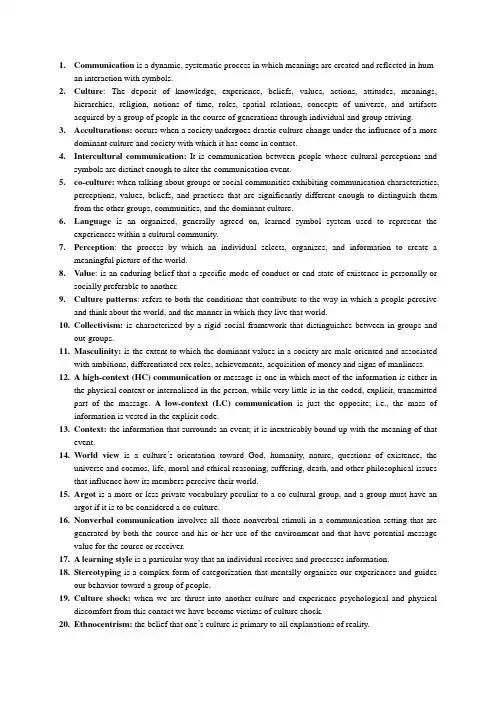
munication is a dynamic, systematic process in which meanings are created and reflected in human interaction with symbols.2.Culture: The deposit of knowledge, experience, beliefs, values, actions, attitudes, meanings,hierarchies, religion, notions of time, roles, spatial relations, concepts of universe, and artifacts acquired by a group of people in the course of generations through individual and group striving.3.Acculturations: occurs when a society undergoes drastic culture change under the influence of a moredominant culture and society with which it has come in contact.4.Intercultural communication:It is communication between people whose cultural perceptions andsymbols are distinct enough to alter the communication event.5.co-culture: when talking about groups or social communities exhibiting communication characteristics,perceptions, values, beliefs, and practices that are significantly different enough to distinguish them from the other groups, communities, and the dominant culture.nguage is an organized, generally agreed on, learned symbol system used to represent theexperiences within a cultural community.7.Perception: the process by which an individual selects, organizes, and information to create ameaningful picture of the world.8.Value: is an enduring belief that a specific mode of conduct or end-state of existence is personally orsocially preferable to another.9.Culture patterns: refers to both the conditions that contribute to the way in which a people perceiveand think about the world, and the manner in which they live that world.10.Collectivism:is characterized by a rigid social framework that distinguishes between in-groups andout-groups.11.Masculinity: is the extent to which the dominant values in a society are male oriented and associatedwith ambitions, differentiated sex roles, achievements, acquisition of money and signs of manliness. 12.A high-context (HC) communication or message is one in which most of the information is either inthe physical context or internalized in the person, while very little is in the coded, explicit, transmitted part of the massage. A low-context (LC) communication is just the opposite; i.e., the mass of information is vested in the explicit code.13.Context: the information that surrounds an event; it is inextricably bound up with the meaning of thatevent.14.World view is a culture’s orientation toward God, humanity, nature, questions of existence, theuniverse and cosmos, life, moral and ethical reasoning, suffering, death, and other philosophical issues that influence how its members perceive their world.15.Argot is a more or less private vocabulary peculiar to a co-cultural group, and a group must have anargot if it is to be considered a co-culture.16.Nonverbal communication involves all those nonverbal stimuli in a communication setting that aregenerated by both the source and his or her use of the environment and that have potential message value for the source or receiver.17.A learning style is a particular way that an individual receives and processes information.18.Stereotyping is a complex form of categorization that mentally organizes our experiences and guidesour behavior toward a group of people.19.Culture shock: when we are thrust into another culture and experience psychological and physicaldiscomfort from this contact we have become victims of culture shock.20.Ethnocentrism: the belief that one’s culture is primary to all explanations of reality.21.Seven characteristics of culture affect communication: learned, transmitted from generation togeneration, based on symbols, dynamic, integrated, ethnocentric, adaptive.22.Belief: our conviction in the truth of something. Learned and subject to cultural interpretation andcultural diversity.23.Individualism:refers to the doctrine, spelled out in detail by the seventeenth. The single mostimportant pattern in the US.24.Hofstede’s Value Dimensions:four parts: individualism-collectivism, uncertainty avoidance, powerdistance, and masculinity and femininity.25.Culture differs in their attitudes toward: individualism and collectivism, uncertainty avoidance,power distance, masculinity and femininity, human nature, the perception of nature, time, activity, relationships, context, formality and informality, assertiveness and interpersonal harmony.26.Religious Similarities: sacred writings, authority, traditional rituals, speculation, ethics.27.Five religious orientations: Christianity, Judaism, Islam, Hinduism, Buddhism.28.the family we are born into the family of orientation and take a spouse the family of procreation.29.problems of translation and equivalence:vocabulary or lexical equivalence, idiomatic and slangequivalence, grammatical-syntactical equivalence, experiential-cultural equivalence, conceptual equivalence.30.The use of argot reflects a co-culture’s need to have a language that permits them to 1.sharemembership,2. participate in their social and cultural communities,3. identify themselves and their place in the universe, 4. communicate with one another about their own social realities.31.Functions of communication: repeating, complementing, substituting, regulating, contradicting.32.The study of how movement communicates is called kinesics. Kinesic cues are those visible bodyshifts and movements that can send messages about 1.our attitude toward the other person 2. our emotional state 3. our desire to control our environment.33.Eyes serve six communication functions: 1. indicates degree of attentiveness, interest, and arousal 2.help intiate and sustain intimate relationships 3. influence attitude change and persuasion 4. regulate interaction 5. communicate emotions 6. define power and status relationships 7. assume a central role in impression management.34.kinds of vocalizations: vocal characterizers, vocal qualifiers, vocal segregates.。

munication is a dynamic, systematic process in which meanings are created and reflected in human interaction with symbols.2.Culture: The deposit of knowledge, experience, beliefs, values, actions, attitudes, meanings,hierarchies, religion, notions of time, roles, spatial relations, concepts of universe, and artifacts acquired by a group of people in the course of generations through individual and group striving.3.Acculturations: occurs when a society undergoes drastic culture change under the influence of a moredominant culture and society with which it has come in contact.4.Intercultural communication:It is communication between people whose cultural perceptions andsymbols are distinct enough to alter the communication event.5.co-culture: when talking about groups or social communities exhibiting communication characteristics,perceptions, values, beliefs, and practices that are significantly different enough to distinguish them from the other groups, communities, and the dominant culture.nguage is an organized, generally agreed on, learned symbol system used to represent theexperiences within a cultural community.7.Perception: the process by which an individual selects, organizes, and information to create ameaningful picture of the world.8.Value: is an enduring belief that a specific mode of conduct or end-state of existence is personally orsocially preferable to another.9.Culture patterns: refers to both the conditions that contribute to the way in which a people perceiveand think about the world, and the manner in which they live that world.10.Collectivism:is characterized by a rigid social framework that distinguishes between in-groups andout-groups.11.Masculinity: is the extent to which the dominant values in a society are male oriented and associatedwith ambitions, differentiated sex roles, achievements, acquisition of money and signs of manliness. 12.A high-context (HC) communication or message is one in which most of the information is either inthe physical context or internalized in the person, while very little is in the coded, explicit, transmitted part of the massage. A low-context (LC) communication is just the opposite; i.e., the mass of information is vested in the explicit code.13.Context: the information that surrounds an event; it is inextricably bound up with the meaning of thatevent.14.World view is a culture’s orientation toward God, humanity, nature, questions of existence, theuniverse and cosmos, life, moral and ethical reasoning, suffering, death, and other philosophical issues that influence how its members perceive their world.15.Argot is a more or less private vocabulary peculiar to a co-cultural group, and a group must have anargot if it is to be considered a co-culture.16.Nonverbal communication involves all those nonverbal stimuli in a communication setting that aregenerated by both the source and his or her use of the environment and that have potential message value for the source or receiver.17.A learning style is a particular way that an individual receives and processes information.18.Stereotyping is a complex form of categorization that mentally organizes our experiences and guidesour behavior toward a group of people.19.Culture shock: when we are thrust into another culture and experience psychological and physicaldiscomfort from this contact we have become victims of culture shock.20.Ethnocentrism: the belief that one’s culture is primary to all explanations of reality.21.Seven characteristics of culture affect communication: learned, transmitted from generation togeneration, based on symbols, dynamic, integrated, ethnocentric, adaptive.22.Belief: our conviction in the truth of something. Learned and subject to cultural interpretation andcultural diversity.23.Individualism:refers to the doctrine, spelled out in detail by the seventeenth. The single mostimportant pattern in the US.24.Hofstede’s Value Dimensions:four parts: individualism-collectivism, uncertainty avoidance, powerdistance, and masculinity and femininity.25.Culture differs in their attitudes toward: individualism and collectivism, uncertainty avoidance,power distance, masculinity and femininity, human nature, the perception of nature, time, activity, relationships, context, formality and informality, assertiveness and interpersonal harmony.26.Religious Similarities: sacred writings, authority, traditional rituals, speculation, ethics.27.Five religious orientations: Christianity, Judaism, Islam, Hinduism, Buddhism.28.the family we are born into the family of orientation and take a spouse the family of procreation.29.problems of translation and equivalence:vocabulary or lexical equivalence, idiomatic and slangequivalence, grammatical-syntactical equivalence, experiential-cultural equivalence, conceptual equivalence.30.The use of argot reflects a co-culture’s need to have a language that permits them to 1.sharemembership,2. participate in their social and cultural communities,3. identify themselves and their place in the universe, 4. communicate with one another about their own social realities.31.Functions of communication: repeating, complementing, substituting, regulating, contradicting.32.The study of how movement communicates is called kinesics. Kinesic cues are those visible bodyshifts and movements that can send messages about 1.our attitude toward the other person 2. our emotional state 3. our desire to control our environment.33.Eyes serve six communication functions: 1. indicates degree of attentiveness, interest, and arousal 2.help intiate and sustain intimate relationships 3. influence attitude change and persuasion 4. regulate interaction 5. communicate emotions 6. define power and status relationships 7. assume a central role in impression management.34.kinds of vocalizations: vocal characterizers, vocal qualifiers, vocal segregates.。
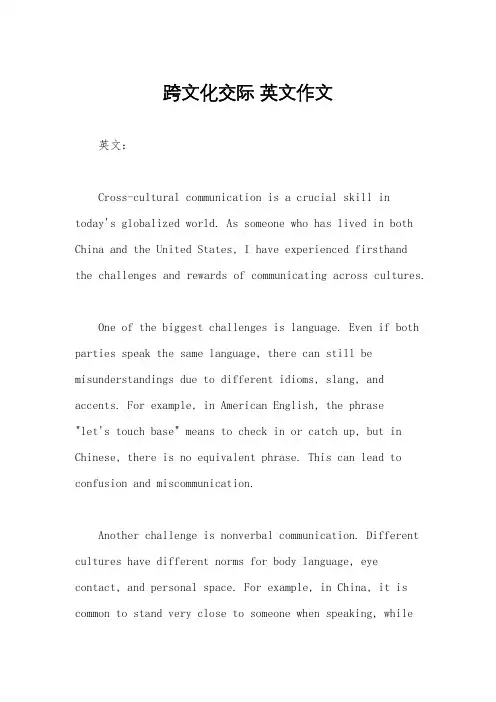
跨文化交际英文作文英文:Cross-cultural communication is a crucial skill intoday's globalized world. As someone who has lived in both China and the United States, I have experienced firsthandthe challenges and rewards of communicating across cultures.One of the biggest challenges is language. Even if both parties speak the same language, there can still be misunderstandings due to different idioms, slang, and accents. For example, in American English, the phrase"let's touch base" means to check in or catch up, but in Chinese, there is no equivalent phrase. This can lead to confusion and miscommunication.Another challenge is nonverbal communication. Different cultures have different norms for body language, eye contact, and personal space. For example, in China, it is common to stand very close to someone when speaking, whilein the United States, people tend to maintain more distance. This can make people from different cultures feel uncomfortable or even offended.However, when cross-cultural communication is done well, it can be incredibly rewarding. It can lead to new friendships, business opportunities, and a deeper understanding of different cultures. For example, when Iwas living in China, I made friends with a local family who invited me to their home for dinner. They taught me about Chinese customs and traditions, and I was able to share my own culture with them. It was a wonderful experience that would not have been possible without cross-cultural communication.中文:跨文化交际是当今全球化世界中至关重要的技能。
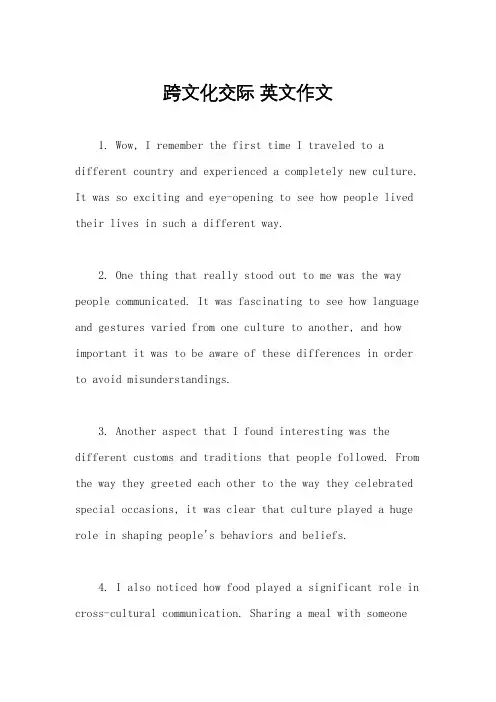
跨文化交际英文作文1. Wow, I remember the first time I traveled to a different country and experienced a completely new culture. It was so exciting and eye-opening to see how people lived their lives in such a different way.2. One thing that really stood out to me was the way people communicated. It was fascinating to see how language and gestures varied from one culture to another, and how important it was to be aware of these differences in order to avoid misunderstandings.3. Another aspect that I found interesting was the different customs and traditions that people followed. From the way they greeted each other to the way they celebrated special occasions, it was clear that culture played a huge role in shaping people's behaviors and beliefs.4. I also noticed how food played a significant role in cross-cultural communication. Sharing a meal with someonefrom a different culture was a great way to connect and learn more about their background and values.5. Overall, my experiences with cross-cultural communication have taught me to be more open-minded and respectful of others' differences. It's important to approach new cultures with curiosity and a willingness to learn, rather than judgment or preconceived notions.。
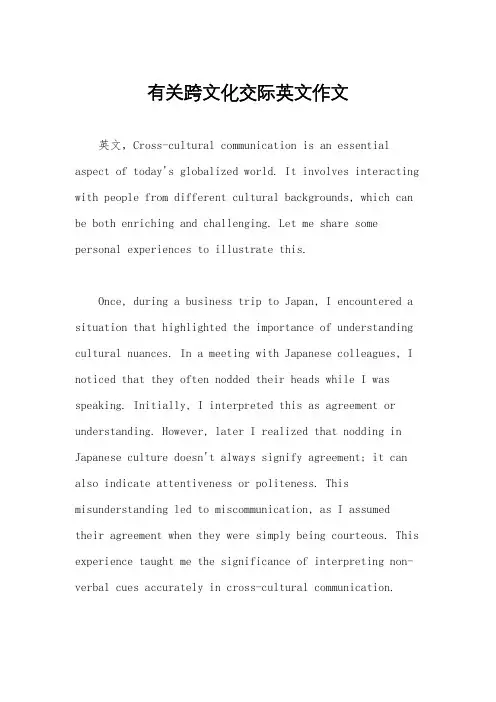
有关跨文化交际英文作文英文,Cross-cultural communication is an essential aspect of today's globalized world. It involves interacting with people from different cultural backgrounds, which can be both enriching and challenging. Let me share some personal experiences to illustrate this.Once, during a business trip to Japan, I encountered a situation that highlighted the importance of understanding cultural nuances. In a meeting with Japanese colleagues, I noticed that they often nodded their heads while I was speaking. Initially, I interpreted this as agreement or understanding. However, later I realized that nodding in Japanese culture doesn't always signify agreement; it can also indicate attentiveness or politeness. This misunderstanding led to miscommunication, as I assumedtheir agreement when they were simply being courteous. This experience taught me the significance of interpreting non-verbal cues accurately in cross-cultural communication.Another instance occurred during a cultural exchange program in Brazil. While conversing with locals, I noticed they often stood close to me and used expressive gestures. At first, I felt uncomfortable with the proximity, as personal space boundaries vary across cultures. However, I gradually adapted and even found it refreshing to engage in such close, animated conversations. This experience taught me the importance of respecting and adapting to different cultural norms, even if they initially seem unfamiliar.中文,跨文化交际在今天全球化的世界中至关重要。
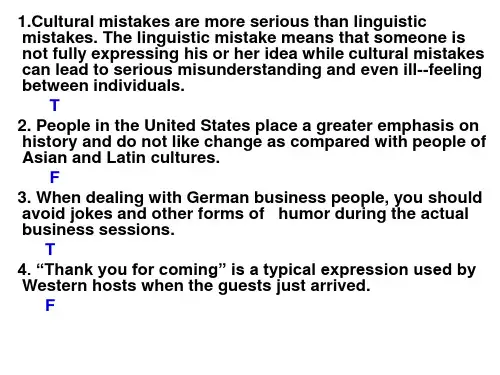
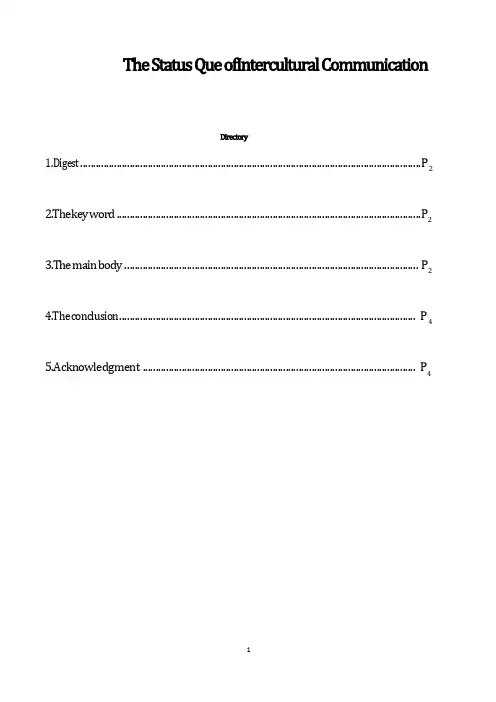
1.Digest................................................................................................................................... P22.The key word ..................................................................................................................... P23.The main body ................................................................................................................. P24.The c onclusion.................................................................................................................. P45.Acknowledgment ......................................................................................................... P4Economic g lobalization h as b rought m ore o pportunities f or C hinese t o e ncounter a nd communicate with f oreigners.However,there a re u psetting p roblems a rising,with t he intercultural c ommunication gaining i ts o wn p opularity.Not j ust r anging f rom t he background of c ulture t o t he s tereotype o f thinking,but t he p atriotism a nd t he ethnocentrism in i ndividual m ind,are a ll o bstacles,in t he s ake f or building e ffective a nd precise communication b etween d ifferent c ulture.Therefore,we a re s upposed t o utilize t he scientist m ethods t o h andle a s eries o f t ypical p roblems.ntercultural c ommunication;the s tereotype o f t hinking;cultural exchangeEven if t he i ndividuals t alk w ith e ach o ther i n t he s ame l anguage,we s till c annot make sure t hat t he can c atch t he c orrect a nd p recise m eanings f orm o thers.It’s b ecause the w ay t hey t hink i s d istinct,the background o f c ulture t hey l ive i n i s d ifferent a nd t he method they u se t o h andle t rouble d iffers f rom ones.Moreover,due t o t he c ultural conflicts and o bstacles,the c ommunications t end t o b e accompanied b y misunderstandings and d istortions i n t he c urrent c onditions.So w hen i t comes t o communication dilemma,p eople t end t o j udge t he b ehaviors a nd w ords o f o thers i n t heir own c ultural acknowledgment,which makes intercultural communication with obvious patriotism and e thnocentrism.With t he d egree o fintercultural c ommunication g rowing,b etween d ifferent c ultures will have a certain d egree o fmutual p enetration.F or e xample,common w ords,s uch a svitamin,the I nternet a nd r adar a re t he d irect t ransliteration o fEnglish.W ords s uch a s Kung Fu,the p aper tiger a nd l ose f ace h ad j oined i nto t he O xford D ictionary.O bviously,with the p rocess o f c ultural e xchange, cultural r epresentation i n t he p roperty r eached a stage o fmutual u nderstanding,t hen f ollowed m ust b e deeper c ultural i ntegration.We n eed t o b reak t he s tereotype o fintercultural c ommunication,.Forexample,majority of C hinese t hink A mericans m ay b e i n f avor o findividualism b ut A sian prefer collectivism.Actually,f acts i s n ot s o.In O yserman’s r esearches,A mericans i n m any field m ore p refer t he m odel of c ollectivism,l ike t he g rade s ystem,a nd m aintaining groups’pared with t hat,Japanese just l ike s uch c ollectivism l ike w orking i n the group.A lso,people u sually t hink A rab t alkingwith o thers w ill sit n early,which m eans they can s mell p ersonal o dor a nd f requently t ouch o thers b ody s how t heir enthusiasm.However,according t o d escriptions o fpeople w ho l ived i n A rab c ountries,t his i s n ot t he case.T hey s ay A rab d o n ot s it n early a ny m ore w hen t alking.Obviously,i fwe i ntend t o clear up t he obstacles o fintercultural c ommunication,u nderstanding t he s tatus q uo i s t he top priority.O therwise,t he efforts o f e stablishing o n p revious c oncepts a nd i deas a re i n vain.The conclusion:Overall,intercultural c ommunication i s i nevitable i n t he g lobal e conomic environment.Then, how t o c ommunicate i n a e fficient a nd a ccurate w ay,i t s till n eeds explore and p ractice.W e m ust m ake clear t hat r educing b arriers i n i ntercultural communication is n ot t hat o ne s ubmits t o t he o ther,but the p eople e ntirely u nderstand their own c ulture a nd t hen l ook f or c ultural c ommon a nd a ttributes between t wocultures.Initial communication i s b ased o n t he c ommon t hing,then w ith t he t alk deeper,the attributes w ould m ake t he c onversation g o o n.[1]Oyserman, D. Coon, H. M. & Kemmelmeier, M. Rethinking individualism and collectivism:Evaluation of theoretical assumptions a nd m eta-analyses[J].Psychological B ulletin,2002,128:3-72.写作能力是对自己所积累的信息进行选择、提取、加工、改造并将之形成为书面文字的能力。
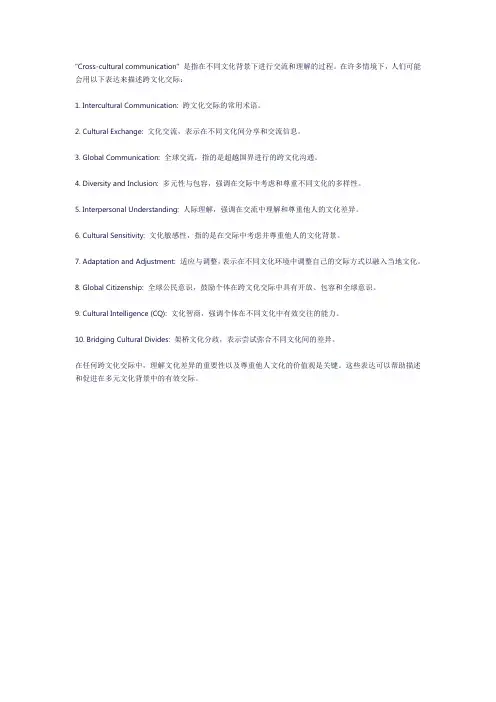
"Cross-cultural communication" 是指在不同文化背景下进行交流和理解的过程。
在许多情境下,人们可能会用以下表达来描述跨文化交际:
1. Intercultural Communication: 跨文化交际的常用术语。
2. Cultural Exchange: 文化交流,表示在不同文化间分享和交流信息。
3. Global Communication: 全球交流,指的是超越国界进行的跨文化沟通。
4. Diversity and Inclusion: 多元性与包容,强调在交际中考虑和尊重不同文化的多样性。
5. Interpersonal Understanding: 人际理解,强调在交流中理解和尊重他人的文化差异。
6. Cultural Sensitivity: 文化敏感性,指的是在交际中考虑并尊重他人的文化背景。
7. Adaptation and Adjustment: 适应与调整,表示在不同文化环境中调整自己的交际方式以融入当地文化。
8. Global Citizenship: 全球公民意识,鼓励个体在跨文化交际中具有开放、包容和全球意识。
9. Cultural Intelligence (CQ): 文化智商,强调个体在不同文化中有效交往的能力。
10. Bridging Cultural Divides: 架桥文化分歧,表示尝试弥合不同文化间的差异。
在任何跨文化交际中,理解文化差异的重要性以及尊重他人文化的价值观是关键。
这些表达可以帮助描述和促进在多元文化背景中的有效交际。


跨文化交际英文版 IMB standardization office【IMB 5AB- IMBK 08- IMB 2C】C r o s s–c u l t u r a l c o m m u n i c a t i o nThesis statement: This paper is mainly talking about the culture differences between several countries.Outline:Chapter 1: Language and culture in communicationChapter2: Culture shockChapter3: What’s in a name?Chapter4: Social interactionChapter 5: Roles and relationsChapter6: Non-verbal communicationChapter 7: In other words.Chapter 8: From a primitive Tribe to a Global VillageConclusionChapter 1: Language and culture in communicationThere is no denying the fact that out daily lives depend largely on communication, without it we can’t know each other. So, we should come to realize that communication is of great importance.What is communication?In total, communication can be divided into two parts; they are verbal communication and non-verbal communication. However, different people hold different opinions about communication. In general, if there is communication, there must have 4 cases: there are at least two or more people, some contact between communicators, a language shared by communicators, an exchange of information has taken place. I just take the fist one for example. Suppose there is one person, there can’t be communication. Otherwise, he may talk to himse lf.Communication not just exist in human-beingsThere are five kinds of communications they are human communication, animal communication, human-animal communication, human machine communication, machine communication. So, Animals and machines can also communicate with each other.For human beings, how can we communicate with each other?Experts say that there are various kinds of communication. Nowadays, there are different kinds of tools for us to communicate .For people we can use telephone and computer to communicate with each other. By them, finally we can receive message.What is social situationWhen there are two or more people gather to do a job or an activity, then it creates a social situation. That is to say, an individual working alone can not constitute a social sA social situation may have two definitions. One is given by the community, and the other by the participants. Finally, we should notice that being polite plays a crucial role in social situation.Chapter2: Culture shockWe should not only know what communication is but we should know what culture shock is.In contemporary society, as our country is developing faster and faster, more and more foreigners will come to our country. Communicating with foreigners is an interesting thing. However, there is no doubt that it can easily cause misunderstanding which is called culture shock. There are several kinds of culture shock.Hospitality: First of all, in Britain, hospitality can not be judged by whether hosts put the food into your dishes, in there, everyone has own dishes, everyone helps themselves. By contrast, in our country, when we have guests, hosts may put the food into guest’s dishes to show their hospitality, so this is different.Politeness: When it comes to this word, in many case, foreigners were described as being polite than Chinese. For example, when we finish work, foreigners may say thank you to us, although it is out duties. However, for Chinese, they seldom say thank you because they think someone who serves them are their duties.What’s more, when we get along with foreigners, we should avoid asking their salaries, jobs and religious and so on. For the young, it’s all right to ask their ages, for the adults, this question is not allowed, especially for the females. But in china, these questions are allowed.In conclusion, when we face these culture shocks, it is better to keep a cool head, and then make an adjustment toward it, finally, we can cope with it. As time goes by, we can adapt it. For example, American Jewish and Israel, the two groups are equal and integration. Both groups have positive attitudes toward one another. So I am sure that after learning this unit, we can know a lot about culture shock and can easily communicate with foreigners.Chapter 3: What’s in a name?The topic of unit three is “what’s in a name?” As is known to all, the English name is different from the Chinese name .The Chinese name consists of family name and given name ,with family name put first. But in contrast, the family name of English name is coming last. Most English people have three names. The last name , or surname is the family name .This is the family name of the father and is given to all his children. And the first name is given to the child at birth, which is called “given name”. And another name used to refer to them is Christian name.However, Chinese name can give all sorts of information about a Chinese people .they may give the address, the birthday ,and also tell us about the family relationship, ethic groups, sex and the parents’ expectation for their children. At the same time, in Chinese the use of kin terms is closely related to age politeness, such as that children are expected to call an old lady, Granny and call a male adult who is older than their fathers, elder uncle. The appropriate and extend use of kin term according to age is taken as reflecting good manners.Chapter4: Social interactionWhat is “social interaction”. It is the topic of unit four. Social interaction is an important way of human existence, and it is different from other animals’ communication. And it’s meaningful. Different countries have different social interactions. Many Chinese people tend to ask age, marital status, and even salary when they meet each other first. To the Chinese people, these are open conversational topic. and Chinese people pay much attention to family life. So in their spare time, they will talk about the family member features as a common topic. It is so natural. And the salary is not a secret .and when a Chinese offers refreshments or drinks to his colleague, his colleague often declines the offer politely, because he don’t want to trouble the person who offers. And it also shows his politeness. But in western countries, if you ask the person who meet you first about these, they will feel so bad. They think it is not polite.Do you know how English native negotiate a time to meet .from the text I know that you may find their way of settling on a time is quite similar to our own, that is , normally one gives or suggests a time, then the other may find it is not suitable and suggest another time, and finally a time is fixed which suits both.Consequently, you can know from above, different countries have different habits.Chapter 7: In other words.Different languages cause some misunderstandingsThere are many countries that their language is the same. such as America , British, Canada, Australia,and so on, they all speak English, people from America and British speak different varieties of English. They usually find little difficulty in understanding each other.However, there are some differences which may cause some misunderstanding, because of profusion of synonyms that they use different words to refer to the same thing. But for other countries which do not speak English they hardly understand the idioms, for example “face the music” in America it means to accept the criticisms, unpleasant consequences, etc . it probably comes from the custom in some Western armies of punishing soldiers to the sound of beating drums, if a person who is come from China may comprehend that enjoy himself by listening to music. on the contrary,they can not understand the meaning of Chinese idioms.There are some similar in languagesWith the exception, both English and Chinese have many such idioms that refer to animals, and some animals have similar associations in both cultures: deer, for example , are bloodthirsty and cruel, ect . But some other animals have rather different associations, like dogs, in the eyes of English-speaking people,dog is loyal ,but in the eyes of Chinese it aways contains derogatory sense are seen rather differently from the way appear to us. About proverb, since human experiences and observations of the world are in many respect similar. in spit of the dissimilar cultural backgrounds of the Chinese and the English-speaking peoples, the number of proverbs or saying in two language that are equivalent or closely approximate is rather surprising.Swearwords is the taboo for every countriesEvery language contains a special group of taboo words which people avoid using because they find them embarrassing or offensive. In many languages, swearwords are taboo, this is generally true of both English and Chinese. In English, certain swearwords seem to be more offensive than others and consequently the social prohibition against their use is stricter.Chapter 8: From a primitive Tribe to a Global VillageAnimals might have astonishing ways of showing their emotions andfeelings.This unit takes us back in to history, inviting us to reflect upon how man has extended his limbs and senses by using new technologies. Nowadays, the technologies are so advanced that communication over long distance can be done in a split of a second. People all over the world are living, quite literally, in a global village. In the textbook, we have learned that animals might have astonishing ways of showing their emotions and feelings. The way different kinds of animals behave, have fascinated great minds since Plato and AristotleCommunication is covering everywhereOne point that is beyond doubt is that our ancestors were extremely handicapped --- in comparison with us now --- in communication. From the Stone Age, to the present day, over2,000,000 years, man has done his best to extend himself in order to improve his way of communication. Writing, printing technology, postal services, telegraph, telephone, radio, picture communication, television, computer and laser technology, internet --- these have extended man’s mouth, eyes, ears, hands, legs, in short the whole body beyond a house, a village, a county, a province, a country, an ocean, a continent, and even beyond the mother earth to the moon and the Mars. Going global is great, but an entirely different tone was heard: Globalization is a menace to mankind. Globalization will make the powers more powerful but the weak is weaker and the poor is poorer.ConclusionDifferent countries have their own cultures, so it causes the different cultures .Consequently, sometimes the people come from different places may cause some misunderstandings. After learning this textbook we can get along well with people all over the world.Finally, through this paper, we can learn more knowledge.。
Case 1 Girl—nessAs a visiting professor in an American university, Zhang Hua was invited to give a lecture to a group of American students。
He talked about university students in China. During the question-and-answer period after the lecture,one female s tudent asked a question that surprised Zhang Hua. “When you talked about female students, you referred to them as girls. Why?”“Because they are girls。
That’s what they are called," Zhang Hua tried to answer,but he knew he did not really understand the in tent of the question. “ I don't quite understand your question,I’m afraid。
”“In the States,we call ourselves ‘ women’ if we're old enough to go to the university. Calling us ‘girls’ is insulting。
”Do Chinese female college students prefer to be called women?Case 2Many years ago,a Chinese man showed a photo of his wife to some American visitors. Out of courtesy,they all said,” She is very beautiful。
有关跨文化交际英文作文英文,Cross-cultural communication is a fascinating aspect of our globalized world. It's not just about speaking different languages; it's about understanding the nuances of different cultures and how they shape communication styles. Let me share some experiences to illustrate this.I remember when I first traveled to China for a business conference. While I had studied Mandarin for a while, nothing prepared me for the intricacies of communication in a business setting. During a negotiation, my Chinese counterpart nodded frequently, which I interpreted as agreement. However, later I realized that nodding in Chinese culture can simply indicate attentiveness, not necessarily agreement. This misunderstanding could have led to a failed deal if I hadn't clarified.Another instance was during a casual conversation witha colleague. I used a common English idiom, "the ball is in your court," to imply that it was his turn to take action. However, he seemed confused by the metaphor. Later, I learned that idioms don't always translate directly, and using them in cross-cultural communication requires caution.Understanding cultural differences in nonverbal communication is also crucial. In some cultures, direct eye contact is a sign of confidence and sincerity, while in others, it may be seen as confrontational or disrespectful.I experienced this firsthand when I traveled to Japan and learned to moderate my eye contact to align with cultural norms.Now, let me switch to Chinese to further elaborate on these experiences.中文,跨文化交际是我们全球化世界中令人着迷的一个方面。
The differences in body language between China and the United Stateslike verbal language, is also a part of culture .Different culture shavedifferent body languages except some world known ones. And in inter cultural communication, the same body language may mean different things.There I will introduce some basic examples, emphasizes the significance of body languages in interculturalcommunication by comparing the body la nguages in the United States and China.Ⅰ.Action is the same, Meaning is different⑴Index finger banging on the templesChinese meaning:Said people are trying to think, meditate.American meaning:Said the man crazy, spirit is not normal.⑵Prick up middlMiddle finger upChinese meaning: Don't have any special meaning.e fingerAmerican meaning: Is a very rude behavior⑶Make a fistChinese meaning: Show power or to try to do something.American meaning:Said Angry⑷Stamping feetChinese meaning: Angry; Angry; Lose heart; regretAmerican meaning: ImpatientⅡ. Meaning is the same, Action is different⑴Come hereChina's body language: Reach out to called people,and Palm down, a few fingers bend several times at the same time.Body language in the u.s. : To called people, palm up, clench fist with the index finger back and forth. (Chinese antipathy to this).⑵"A shame" ,“unabashed” (a joke)China's body language: Stretched out index finger, with your fingertips on his face a few strokes, like itching, but the fingers are straight Body language in the u.s. : Stretched out his hands index finger, palms down, wipe with a forefinger index finger on the back of another.⑶"I'm full." (after dinner)China's body language: With one hand or both hands gently patted his belly Body language in the u.s. : Place one hand on your throat, palms down, often say "here" at the same time.Not all of the examples here, but can explain the difference of body language, also understand the importance of body language in another language. In a sense, all body language should be put in specific situations to understand, otherwise,Ignoring the whole situation will happen misunderstanding.。
什么是跨文化交际?跨文化交际是什么?所谓跨文化交际,即不同文化背景的人走到一起分享思想、感情和信息时所发生的一切。
跨文化交际的英语名是Intercultural munication,早期也称为Cross-cultural munication。
跨文化交际学最先在美国兴起。
美国是个移民国家,文化碰撞时有发生。
来自世界各地的移民都强调并维护自己的文化,因此形成了美国的多元文化格局。
于是跨文化交际引起了美国学者和各界人士的广泛关注。
日本也不甘落后,于1972年在东京率先召开了第一届跨文化交际学国际研讨会,出席人数超过两千。
1974年,跨文化教育训练与研究学会(SIETAR,Society for Intercultural Education,Training and Research)在美国正式宣布成立。
我国研究跨文化交际学起步较晚。
北京外国语大学著名语言学家胡文仲教授于80年代初期开始从事跨文化交际学的研究,著作颇丰,目前已经编著出版了《跨文化交际学概论》跨文化与语言交际》等多部图书。
目前,跨文化交际学已发展成为一门被国际学者们充分重视的集人类学、语言学、心理学、传播学、社会学等为一体的综合性学科。
什么是跨文化交际能力就是拥有能够和你不同文化的人进行正常有效沟通的能力啊。
比如和其他国家的人,或者其他民族的人交流,你们生活的地域不同,文化也不同,风俗习惯不同,思考方式自然也不同。
比如同样的手势,在不同的文化中可能代表截然相反的概念。
这就要求交流者同时了解这两种文化的背景,才能进行有效的沟通。
跨文化交际的内容简介《跨文化交际》是“新编研究生英语系列教材”之一。
本系列教材是外教社组织国内10余所重点高校的专家、教授,在广泛的市场调研和对当前研究生英语教学实际情况进行详细分析的基础上,倾力打造而成,以满足新时期人才培养的需要,和多样化、个性化的学习需求。
跨文化交际的内容简介改革开放以来,中国发生了翻天覆地的变化,国际化”与国际接轨”这样的字眼,已在中国广泛使用。